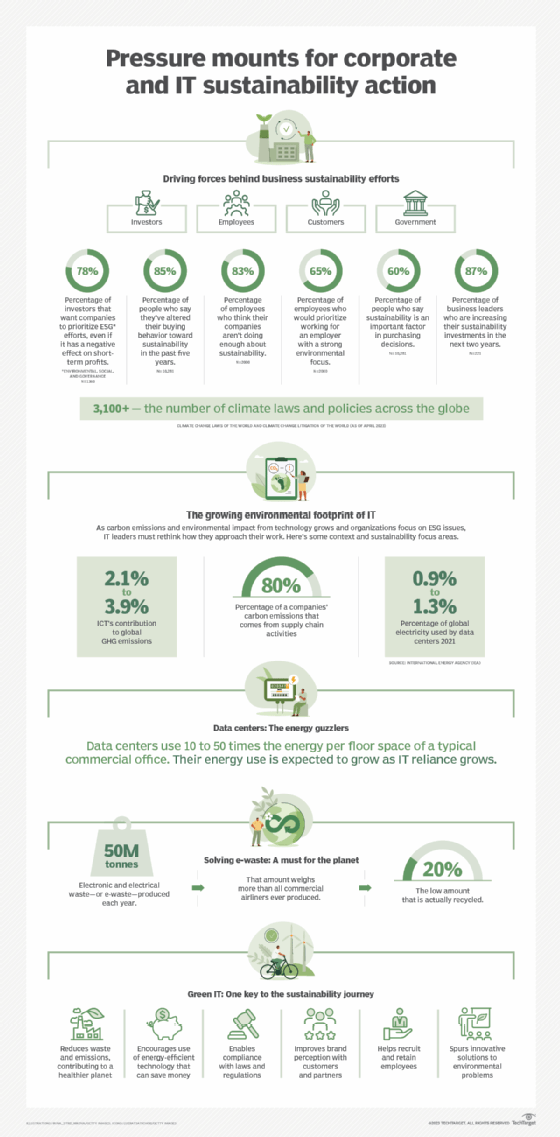
6 ways climate change will affect businesses
Learn about six important effects climate change is having -- and will continue to have -- on the business sector, and why action from leaders and employees is critical.
Climate change is a problem that only gets worse when ignored.
In fact, it's already bringing about numerous changes that affect every region on Earth. From more intense rainfall and flooding to more frequent heatwaves and droughts, these changes will only increase in severity and frequency if climate change is not swiftly and systematically addressed within the next 25 years.
Similarly, climate change already affects businesses around the globe. These effects and the changes that accompany them will grow more severe over time and reverberate across industries. To plan for and meet these changes head-on, businesses everywhere must understand the climate risks they face.
Explore six ways climate change could affect organizations in the near future.
1. Increased costs
In the face of mounting losses due to more frequent and extreme weather events, insurers are adjusting their pricing and investment decisions, resulting in reduced coverage and higher premiums.
Economic losses from natural disasters were around $162 billion in the first half of 2025, according to Aon, a professional services firm. Aon projects that insured losses may reach up to $100 billion by the end of 2025, which would be the second-highest total on record since 2011. In the U.S., losses were primarily driven by climate-related events, such as the California wildfires and multiple severe convective storm outbreaks.
Given the risk that natural disasters and chronic climate conditions will worsen in the years to come, businesses must consider how rising insurance costs and more expensive coverage may affect their bottom line. This is especially true as the global insurance protection gap is at its lowest, at a mere 38%.
In addition to rising insurance costs, businesses may have to contend with cost increases related to the following:
- Energy consumption. Many modern buildings and their infrastructure are not optimized for climate extremes. Rapidly rising temperatures and more extreme heat-related weather events will require increased cooling to protect both people and sensitive technologies, like servers in data centers. This, in turn, will likely increase energy consumption and incur additional costs.
- Worker availability losses. Industries like construction are particularly vulnerable to worker availability losses, as workers are exposed to climate extremes and other climate-health effects in the field, such as heat and air pollution.
- Water supply. Water will be in higher demand than ever due to climate-related risks, like heat stress. Lack of water availability will result in a more constrained water supply and higher water costs, which is particularly worrisome for those in water-scarce regions or those with water-intensive business operations.
- Materials. Mitigating climate risks will help maintain supply chain resilience and access to materials. Some materials, such as finite resources or those difficult to extract, will face dwindling supplies in the face of climate change, which may make resource extraction more challenging or dangerous. This may increase overall manufacturing and production costs or force some businesses to turn to alternatives that may be costly in different ways.
- Business continuity. With more extreme weather events on the horizon, businesses everywhere must develop more thorough business continuity and disaster recovery strategies to maintain operations and minimize downtime related to climate-induced disasters. As insurers adapt their policies to factor in climate risks, businesses must also consider that disaster-related damage might not be covered as extensively, resulting in more recovery and rehabilitation costs.
2. Physical risks
Some environmental risks the Intergovernmental Panel on Climate Change (IPCC) identified include acute physical risks, such as more intense and frequent extreme weather events -- like hurricanes and wildfires -- and chronic physical risks, which are changes brought about over a longer period, such as rising sea levels over many years. Businesses must consider how to mitigate the effects of these risks in the short and long term.
Physical risks can affect business facilities and their suppliers, causing issues such as logistical shipping problems and sudden inventory loss. They can also affect employees' ability to go to work. Some employees may not be able to physically travel to work or may need to take time off to repair or find new housing due to fires, floods, heatwaves and other climate issues. They can even cause expensive infrastructure damage or lead to extended periods of downtime as systems come back online.
For example, the 27 weather events and climate disasters in 2024 each incurred damages of $1 billion or more, according to a report from the National Oceanic and Atmospheric Administration's National Centers for Environmental Information. Combined, the cost was about $182.7 billion.
These disasters were caused by more intense and extreme weather events, including the following:
- Winter storms and cold waves.
- Wildfires.
- Droughts.
- Heatwaves.
- Flooding.
- Tornadoes.
- Cyclones.
- Severe hail events.
Other examples of physical risks include the following:
- Property damage.
- Equipment and asset damage.
- Yield reductions.
- Water scarcity.
- Mining disruptions.
- Reduced materials.
- Resource availability.
Businesses in a future shaped by climate change must learn to identify and assess physical risks and plan ways to mitigate or avoid damage.

3. Regulatory and financial risks
Regulatory risks
As climate action intensifies, businesses will navigate a more complex regulatory landscape and stricter compliance requirements. Failure to comply may result in financial penalties and other types of sanctions, such as the revocation of permits or licenses in certain jurisdictions. These can have wide-ranging effects and could completely halt operations depending on the severity of the punishments.
For example, some U.S. states are enacting climate-related bills. New York's Department of Environmental Conservation proposed a mandatory greenhouse gas (GHG) reporting program as part of its wider climate efforts. Starting in 2027, this program would require certain organizations to report their GHG emissions annually. Failure to comply could result in penalties or formal enforcement actions.
Additionally, the European Parliament passed the Carbon Border Adjustment Mechanism (CBAM) in 2023. CBAM requires EU importers to declare the emissions embedded in their imports. Importers are then required to purchase certificates to cover their declared emissions, essentially functioning as a carbon tariff. This regulation was designed to support the decarbonization of EU industries and foster cleaner industrial production in countries outside the EU.
This type of financial liability will directly affect businesses that trade with EU territories, and those in carbon-intensive industries will need to adapt accordingly. Failure to comply could lead to more severe repercussions, such as a complete import ban.
Financial risks
In addition to regulatory risk, organizations may face other types of climate-related financial risks, such as business continuity and market disruptions. Climate change can affect continuity due to increasingly interconnected business processes and systems. For example, if climate change negatively affects certain supply chain partners, it could cause a disruption that cascades all the way down the chain, even affecting customer experience.
Market disruptions may also become more frequent due to climate-related risks. For example, the more erratic weather caused by climate change disrupts vulnerable crops, such as coffee, leading to global supply shortages and higher prices for in-demand commodities. Disruptions like this can make it difficult to predict resource availability and production costs, which can affect the bottom line.
In the face of such uncertainty, integrating climate risk into business continuity plans and risk management processes will help navigate or even prevent harmful effects.
4. Changing consumer demand
Businesses aren't the only ones grappling with climate change; consumers face similar challenges. Extreme weather events disrupt many communities, with expanded flooding and relentless droughts displacing people, and purse strings are tightening as customers struggle to afford necessities due to resource constraints.
Many consumers face financial strains driven by climate change, including higher healthcare costs, gas and heating bills, and property damage. These strains can lead to decreased consumer spending and shifts in consumer demand for certain products and services.
For example, more consumers than ever seek out sustainable products. More than 60% of U.S. consumers surveyed said they would pay more for a product with sustainable packaging, according to a McKinsey sentiment survey. Younger generations, in particular, expect businesses and products to demonstrate a commitment to sustainability and transparency.
All businesses must consider these shifting consumer demands and plan accordingly to avoid revenue losses. They also represent an opportunity: Businesses that embrace transparency and commit to building environmentally friendly products can meet consumer demand for sustainability and stand out from the competition.
5. Liability risks and legal implications
As public sentiment around sustainability grows and regulators become more aggressive, climate litigation will rise and expose more businesses to liability risks and potential lawsuits. Categories of litigation include claims related to corporate liability and responsibility for climate-related harms, failure to adapt to the effects of climate change, inadequate climate disclosures and misleading claims, among others.
As climate initiatives evolve, organizations that rely on fossil fuels will face greater scrutiny. Potential legal challenges from climate change may extend even further, encapsulating everything from failing to keep stakeholders adequately informed about corporate environmental impacts to the company's role in climate change, which could potentially harm or displace groups of people.
Given these liability risks and legal implications, businesses must consider the ramifications of their climate action or non-action. They must commit to greater accountability and transparency to demonstrate their efforts to protect the environment and those vulnerable to climate change.
6. Resource and materials scarcity
Global population growth has increased the demand for natural resources, including water, energy, minerals, metals and food. This places immense pressure on the environment. For example, mining for resources and clearing land for agricultural purposes releases more GHGs. In turn, resources are more difficult to extract and more costly to obtain, which can affect prices and limit access.
The interdependence between climate change and resource scarcity will only amplify its effect on the global economy, especially if businesses continue to compete for supplies without supporting more sustainable infrastructure or transitioning to renewable resources.
One example of materials scarcity is in the technology sector: Europe's economy has become dependent on what's known as critical raw materials (CRMs), such as lithium -- which are vital to the economy with no viable substitutes. CRMs are used in many modern technologies, including smartphones, IT equipment and even clean technologies, like solar panels.
However, CRMs are extracted using hazardous chemicals and have severe negative environmental repercussions -- and they're in short supply globally. To create better climate practices, leaders are looking to circular economy processes and other ways of addressing dwindling supplies and harmful mining practices.
For example, more businesses are moving away from finite resources, CRMs and fossil fuels, and evaluating alternative options, including the use of refurbished or recycled materials. They are also transitioning to renewable and clean energy to avoid exacerbating resource and materials scarcity.
How can businesses adapt to climate change?
Climate change isn't just about rising temperatures. If left unchecked, it will have a large-scale, widespread impact on the planet and everything living on it. But people across industries and sectors can come together and change that.
Aggressive climate actions to lower GHG emissions have the power to limit climate change, according to the IPCC and other sources. This will require a concerted effort by organizations worldwide to curb emissions and commit to more sustainable operations within the next 25 years.
Here are a few ways to start:
- Conduct an assessment to measure the business's environmental impact, including data related to emissions, as well as a risk assessment to understand potential effects of climate change on the business.
- Map out suppliers, evaluate their environmental impact and partner with sustainable providers across the supply chain.
- Source materials responsibly and move away from raw material dependence wherever possible.
- Transition to renewable energy sources organization-wide to reduce harmful emissions related to fossil fuels.
- Explore and identify ways to reduce the business's carbon footprint as much as possible.
- Adopt green programs, such as initiatives to encourage recycling and reduce single-use packaging and plastics, to make the office more sustainable.
- Have IT teams support sustainability efforts and move to green computing practices, such as responsibly recycling electronics and optimizing power management.
- Develop robust disaster recovery and business continuity plans to maintain uptime and minimize disruptions driven by climate-related events.
- Establish a compliance officer to conduct audits, oversee reporting and ensure adherence to climate change-related regulations and policies.
- Set, implement and monitor KPIs and report against industry benchmarks to ensure continuous improvement in sustainability.
If the world can come together and curb climate change, then many of the effects outlined here and by the IPCC can be avoided. But this isn't something that can be ignored. Every person and organization must commit to doing their part.
Editor's note: This article was originally published in 2023 and updated to reflect updates in news about and best practices for climate change.
Jacob Roundy is a freelance writer and editor with more than a decade of experience with specializing in a variety of technology topics, such as data centers, business intelligence, AI/ML, climate change and sustainability. His writing focuses on demystifying tech, tracking trends in the industry, and providing practical guidance to IT leaders and administrators.







